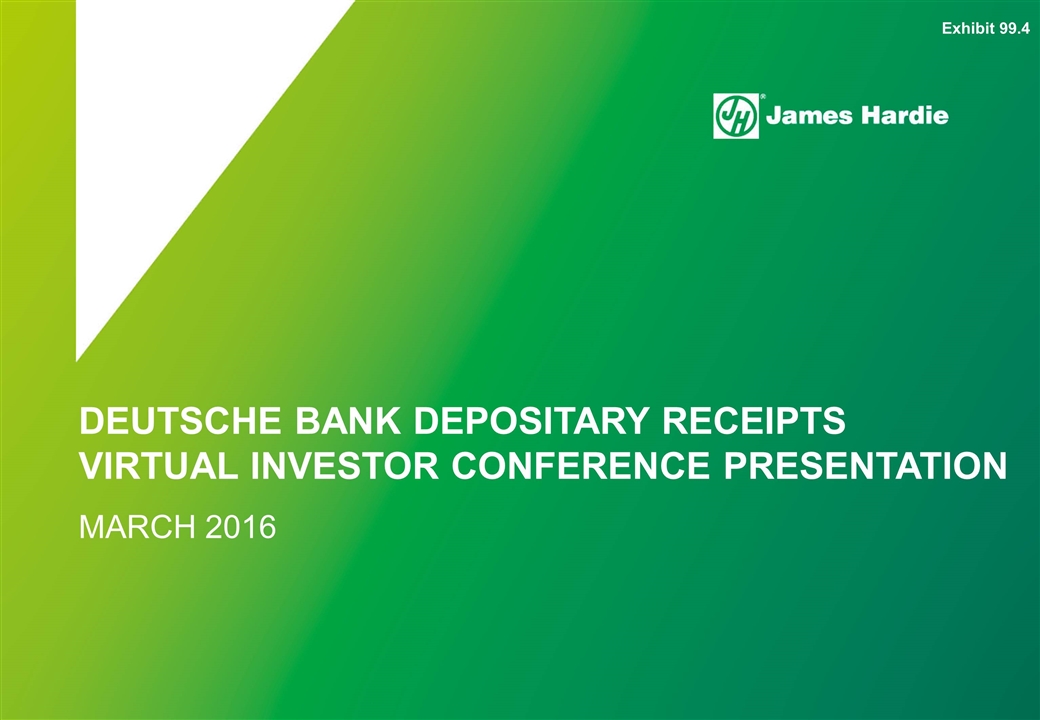

DEUTSCHE BANK DEPOSITARY RECEIPTS VIRTUAL INVESTOR CONFERENCE PRESENTATION MARCH 2016 Exhibit 99.4
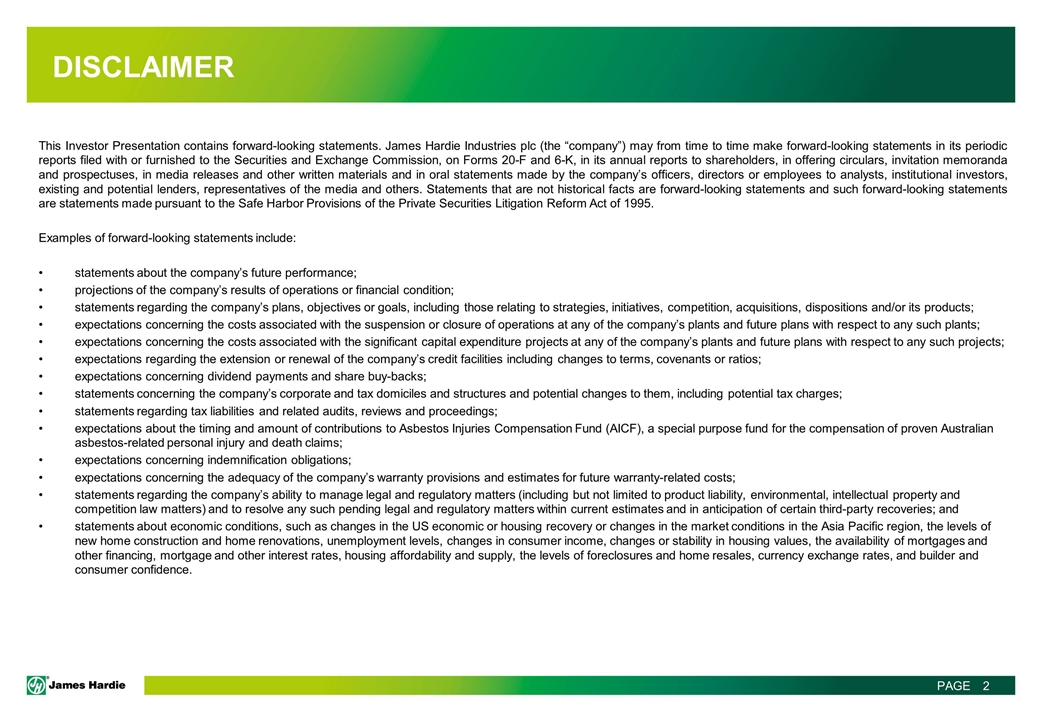
DISCLAIMER This Investor Presentation contains forward-looking statements. James Hardie Industries plc (the “company”) may from time to time make forward-looking statements in its periodic reports filed with or furnished to the Securities and Exchange Commission, on Forms 20-F and 6-K, in its annual reports to shareholders, in offering circulars, invitation memoranda and prospectuses, in media releases and other written materials and in oral statements made by the company’s officers, directors or employees to analysts, institutional investors, existing and potential lenders, representatives of the media and others. Statements that are not historical facts are forward-looking statements and such forward-looking statements are statements made pursuant to the Safe Harbor Provisions of the Private Securities Litigation Reform Act of 1995. Examples of forward-looking statements include: statements about the company’s future performance; projections of the company’s results of operations or financial condition; statements regarding the company’s plans, objectives or goals, including those relating to strategies, initiatives, competition, acquisitions, dispositions and/or its products; expectations concerning the costs associated with the suspension or closure of operations at any of the company’s plants and future plans with respect to any such plants; expectations concerning the costs associated with the significant capital expenditure projects at any of the company’s plants and future plans with respect to any such projects; expectations regarding the extension or renewal of the company’s credit facilities including changes to terms, covenants or ratios; expectations concerning dividend payments and share buy-backs; statements concerning the company’s corporate and tax domiciles and structures and potential changes to them, including potential tax charges; statements regarding tax liabilities and related audits, reviews and proceedings; expectations about the timing and amount of contributions to Asbestos Injuries Compensation Fund (AICF), a special purpose fund for the compensation of proven Australian asbestos-related personal injury and death claims; expectations concerning indemnification obligations; expectations concerning the adequacy of the company’s warranty provisions and estimates for future warranty-related costs; statements regarding the company’s ability to manage legal and regulatory matters (including but not limited to product liability, environmental, intellectual property and competition law matters) and to resolve any such pending legal and regulatory matters within current estimates and in anticipation of certain third-party recoveries; and statements about economic conditions, such as changes in the US economic or housing recovery or changes in the market conditions in the Asia Pacific region, the levels of new home construction and home renovations, unemployment levels, changes in consumer income, changes or stability in housing values, the availability of mortgages and other financing, mortgage and other interest rates, housing affordability and supply, the levels of foreclosures and home resales, currency exchange rates, and builder and consumer confidence.
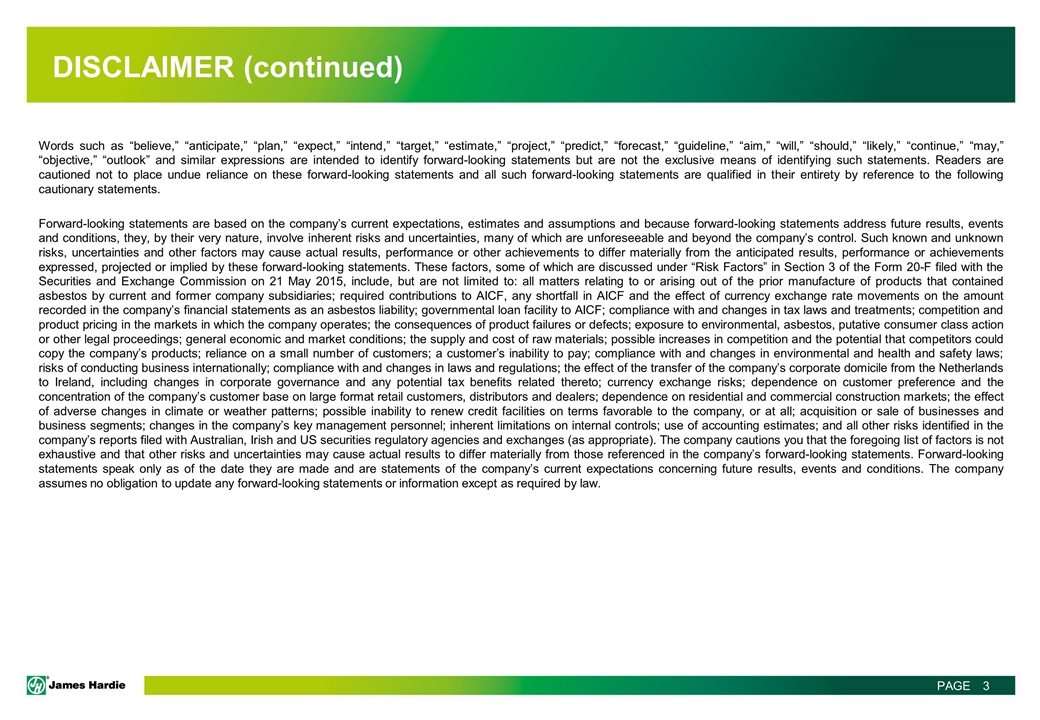
DISCLAIMER (continued) Words such as “believe,” “anticipate,” “plan,” “expect,” “intend,” “target,” “estimate,” “project,” “predict,” “forecast,” “guideline,” “aim,” “will,” “should,” “likely,” “continue,” “may,” “objective,” “outlook” and similar expressions are intended to identify forward-looking statements but are not the exclusive means of identifying such statements. Readers are cautioned not to place undue reliance on these forward-looking statements and all such forward-looking statements are qualified in their entirety by reference to the following cautionary statements. Forward-looking statements are based on the company’s current expectations, estimates and assumptions and because forward-looking statements address future results, events and conditions, they, by their very nature, involve inherent risks and uncertainties, many of which are unforeseeable and beyond the company’s control. Such known and unknown risks, uncertainties and other factors may cause actual results, performance or other achievements to differ materially from the anticipated results, performance or achievements expressed, projected or implied by these forward-looking statements. These factors, some of which are discussed under “Risk Factors” in Section 3 of the Form 20-F filed with the Securities and Exchange Commission on 21 May 2015, include, but are not limited to: all matters relating to or arising out of the prior manufacture of products that contained asbestos by current and former company subsidiaries; required contributions to AICF, any shortfall in AICF and the effect of currency exchange rate movements on the amount recorded in the company’s financial statements as an asbestos liability; governmental loan facility to AICF; compliance with and changes in tax laws and treatments; competition and product pricing in the markets in which the company operates; the consequences of product failures or defects; exposure to environmental, asbestos, putative consumer class action or other legal proceedings; general economic and market conditions; the supply and cost of raw materials; possible increases in competition and the potential that competitors could copy the company’s products; reliance on a small number of customers; a customer’s inability to pay; compliance with and changes in environmental and health and safety laws; risks of conducting business internationally; compliance with and changes in laws and regulations; the effect of the transfer of the company’s corporate domicile from the Netherlands to Ireland, including changes in corporate governance and any potential tax benefits related thereto; currency exchange risks; dependence on customer preference and the concentration of the company’s customer base on large format retail customers, distributors and dealers; dependence on residential and commercial construction markets; the effect of adverse changes in climate or weather patterns; possible inability to renew credit facilities on terms favorable to the company, or at all; acquisition or sale of businesses and business segments; changes in the company’s key management personnel; inherent limitations on internal controls; use of accounting estimates; and all other risks identified in the company’s reports filed with Australian, Irish and US securities regulatory agencies and exchanges (as appropriate). The company cautions you that the foregoing list of factors is not exhaustive and that other risks and uncertainties may cause actual results to differ materially from those referenced in the company’s forward-looking statements. Forward-looking statements speak only as of the date they are made and are statements of the company’s current expectations concerning future results, events and conditions. The company assumes no obligation to update any forward-looking statements or information except as required by law.

AGENDA Global Strategy and Business Overview North America and Europe Fiber Cement Asia Pacific Fiber Cement Capital Management Framework Appendix In this Investor Presentation, the company may present financial measures, sales volume terms, financial ratios, and Non-US GAAP financial measures included in the Definitions and other terms section of this document. The company presents financial measures that it believes are customarily used by its Australian investors. Specifically, these financial measures, which are equivalent to or derived from certain US GAAP measures as explained in the definitions, include “EBIT”, “EBIT margin”, “Operating profit before income taxes” and “Net operating profit”. The company may also present other terms for measuring its sales volume (“million square feet” or “mmsf” and “thousand square feet” or “msf”); financial ratios (“Gearing ratio”, “Net interest expense cover”, “Net interest paid cover”, “Net debt payback”, “Net debt (cash)”); and Non-US GAAP financial measures (“Adjusted EBIT”, “Adjusted EBIT margin”, “Adjusted net operating profit”, “Adjusted diluted earnings per share”, “Adjusted operating profit before income taxes”, “Adjusted effective tax rate on earnings”, “Adjusted EBITDA”, and “Adjusted selling, general and administrative expenses”. Unless otherwise stated, results and comparisons are of the third quarter of the current fiscal year versus the third quarter of the prior fiscal year.
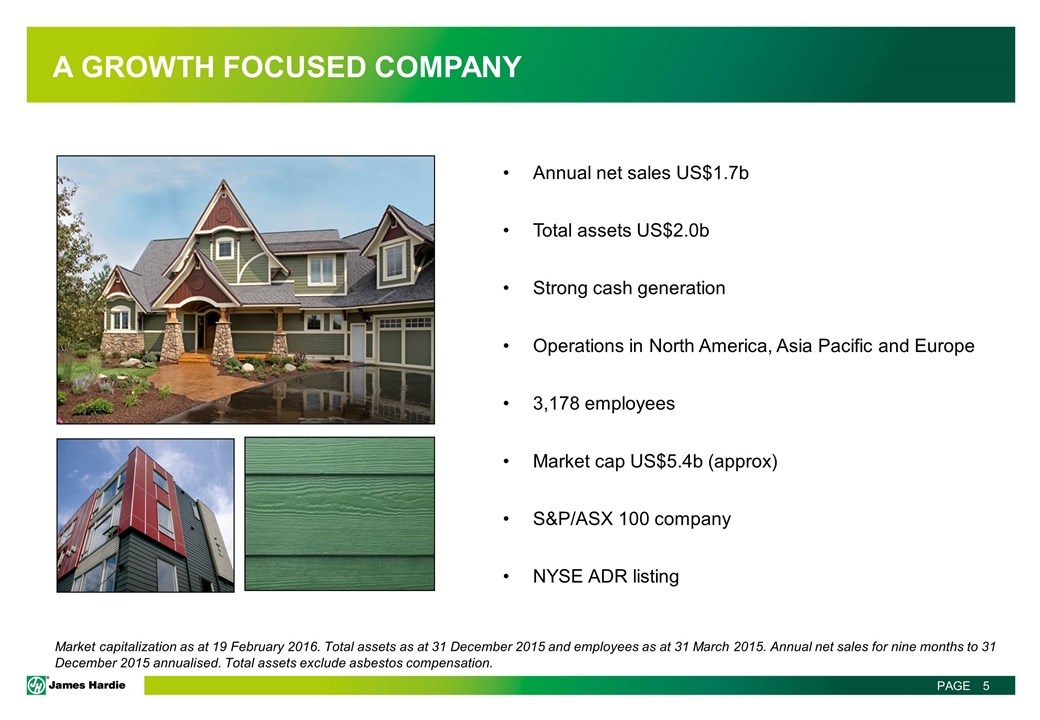
Annual net sales US$1.7b Total assets US$2.0b Strong cash generation Operations in North America, Asia Pacific and Europe 3,178 employees Market cap US$5.4b (approx) S&P/ASX 100 company NYSE ADR listing Market capitalization as at 19 February 2016. Total assets as at 31 December 2015 and employees as at 31 March 2015. Annual net sales for nine months to 31 December 2015 annualised. Total assets exclude asbestos compensation. A GROWTH FOCUSED COMPANY
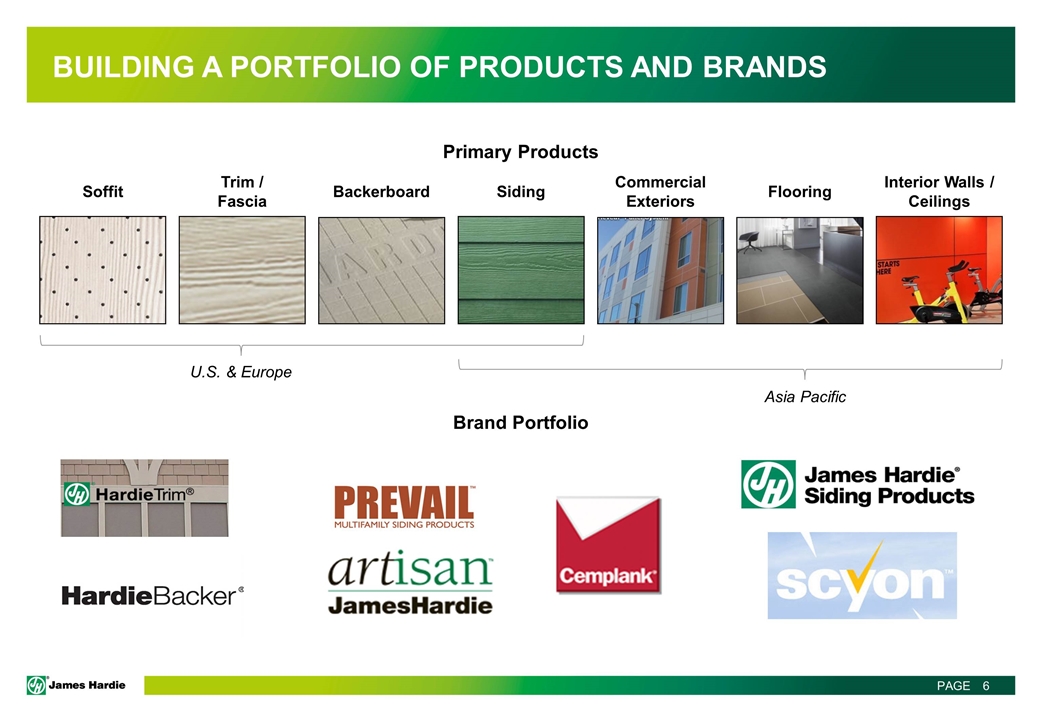
Siding Primary Products Soffit Trim / Fascia Backerboard Commercial Exteriors Flooring Interior Walls / Ceilings Brand Portfolio U.S. & Europe Asia Pacific BUILDING A PORTFOLIO OF PRODUCTS AND BRANDS

WORLD LEADER IN FIBER CEMENT Geographic Mix¹ Net Sales EBIT ² 1 All percentages are as at 31 December 2015 and numbers are for the full year ended 31 March 2015 ² EBIT – excludes research and development, asbestos-related expenses and adjustments and New Zealand weathertightness claims Asia Pacific 19% Asia Pacific 20% North America and Europe 81% Employees¹ 2,269 in North America and Europe 909 in Asia Pacific
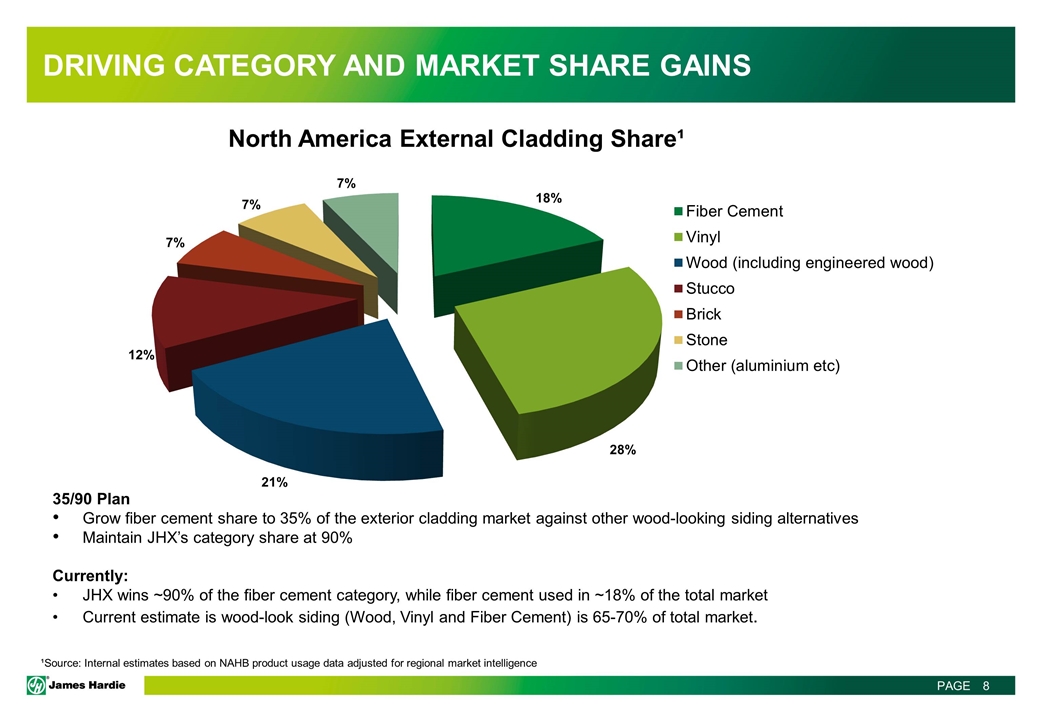
35/90 Plan Grow fiber cement share to 35% of the exterior cladding market against other wood-looking siding alternatives Maintain JHX’s category share at 90% Currently: JHX wins ~90% of the fiber cement category, while fiber cement used in ~18% of the total market Current estimate is wood-look siding (Wood, Vinyl and Fiber Cement) is 65-70% of total market. ¹Source: Internal estimates based on NAHB product usage data adjusted for regional market intelligence DRIVING CATEGORY AND MARKET SHARE GAINS North America External Cladding Share¹
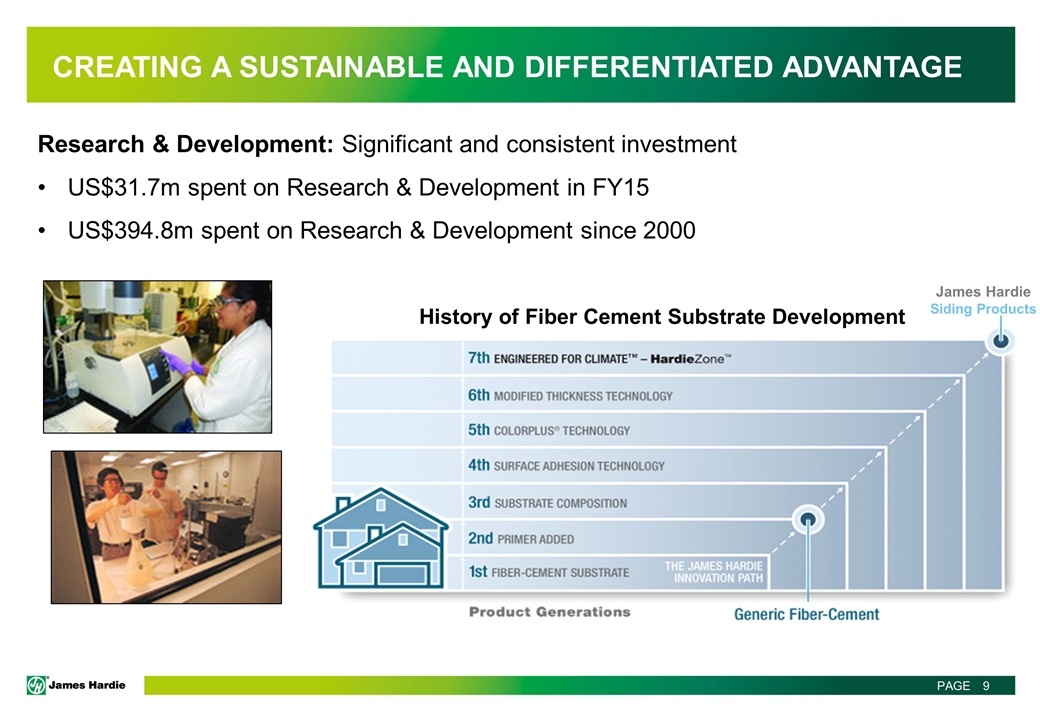
Research & Development: Significant and consistent investment US$31.7m spent on Research & Development in FY15 US$394.8m spent on Research & Development since 2000 CREATING A SUSTAINABLE AND DIFFERENTIATED ADVANTAGE History of Fiber Cement Substrate Development James Hardie Siding Products
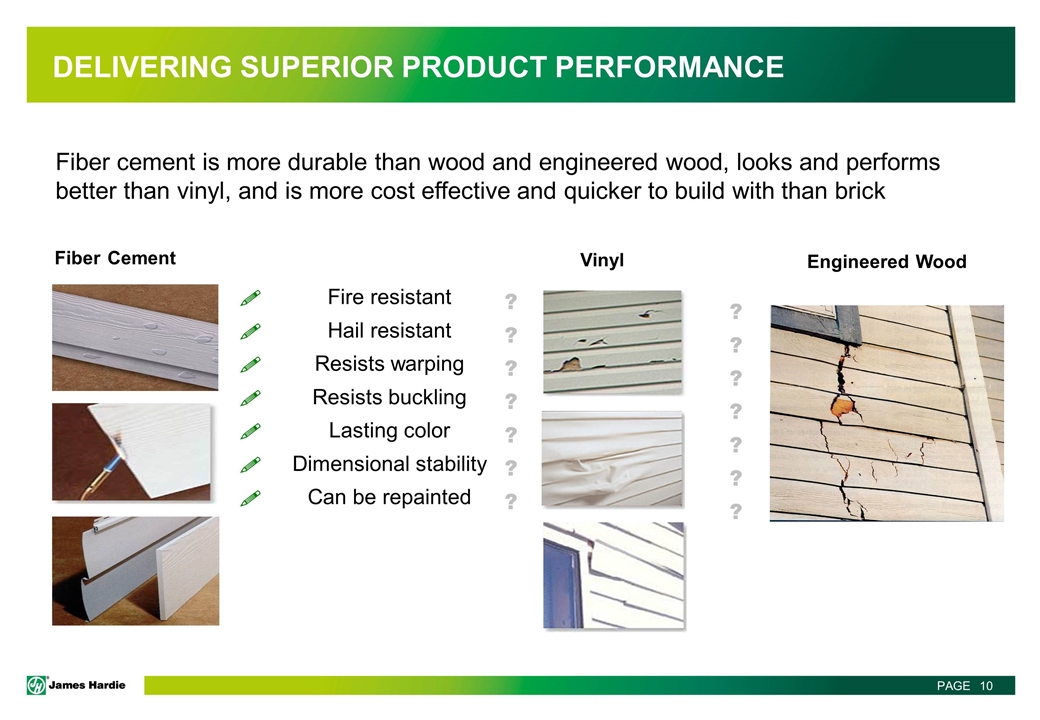
Fiber cement is more durable than wood and engineered wood, looks and performs better than vinyl, and is more cost effective and quicker to build with than brick Fiber Cement Vinyl Engineered Wood ! ! ! ! ! ! ! Fire resistant Hail resistant Resists warping Resists buckling Lasting color Dimensional stability Can be repainted ? ? ? ? ? ? ? ? ? ? ? ? ? ? DELIVERING SUPERIOR PRODUCT PERFORMANCE
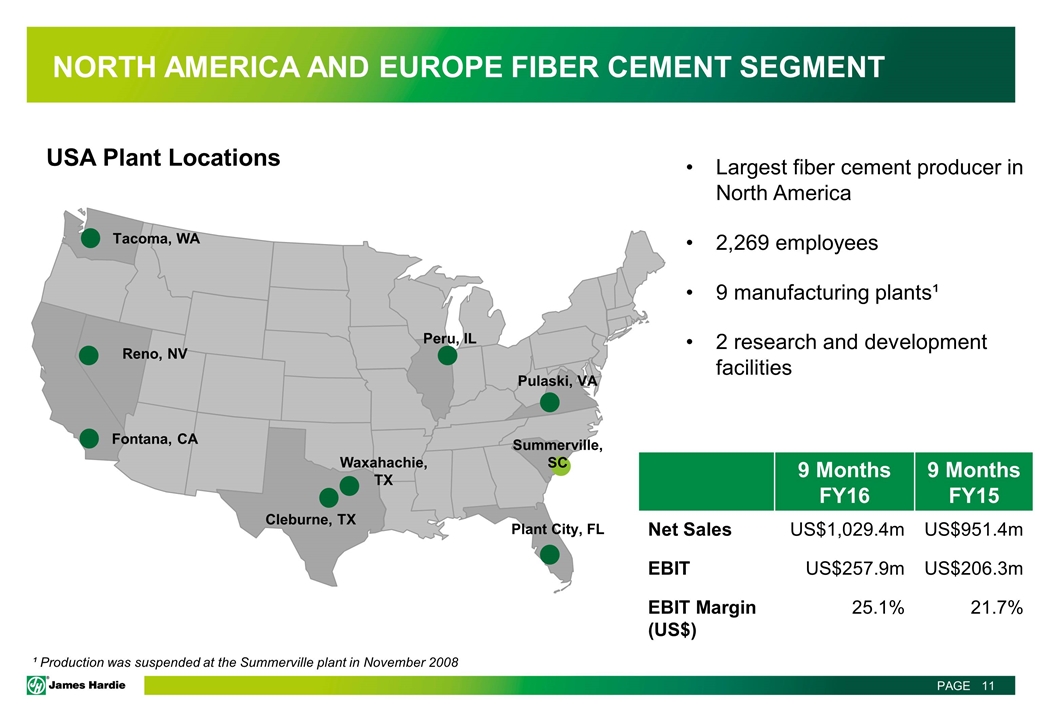
¹ Production was suspended at the Summerville plant in November 2008 USA Plant Locations NORTH AMERICA AND EUROPE FIBER CEMENT SEGMENT Tacoma, WA Reno, NV Fontana, CA Waxahachie, TX Cleburne, TX Summerville, SC Plant City, FL Pulaski, VA Peru, IL Largest fiber cement producer in North America 2,269 employees 9 manufacturing plants¹ 2 research and development facilities 9 Months FY16 9 Months FY15 Net Sales US$1,029.4m US$951.4m EBIT US$257.9m US$206.3m EBIT Margin (US$) 25.1% 21.7%
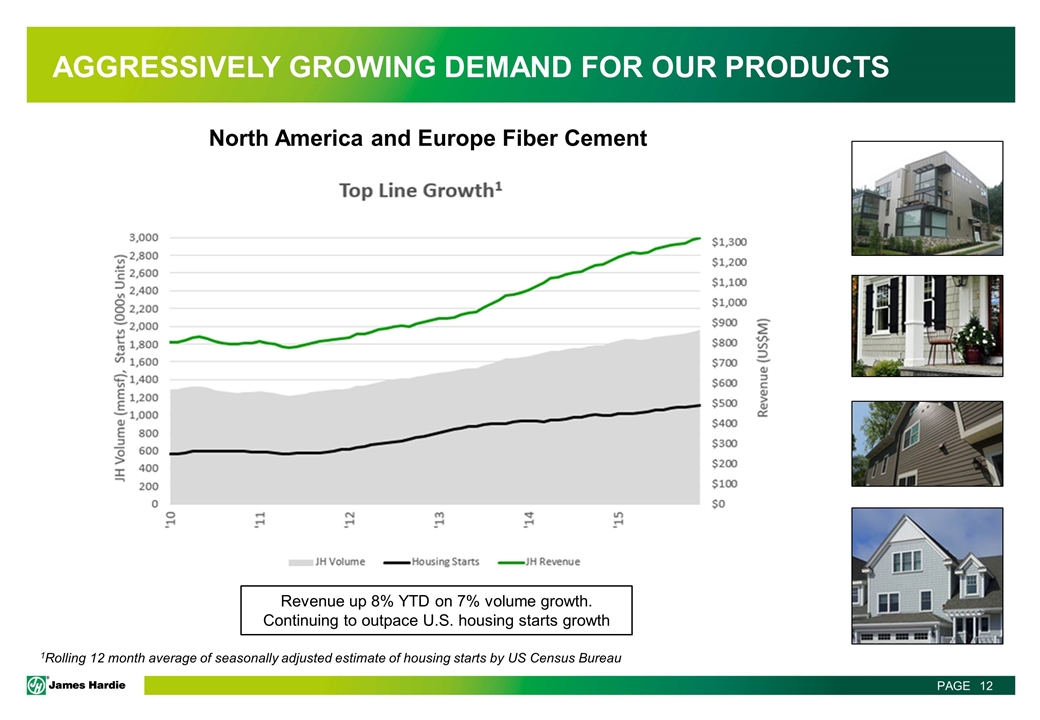
1Rolling 12 month average of seasonally adjusted estimate of housing starts by US Census Bureau AGGRESSIVELY GROWING DEMAND FOR OUR PRODUCTS Revenue up 8% YTD on 7% volume growth. Continuing to outpace U.S. housing starts growth North America and Europe Fiber Cement
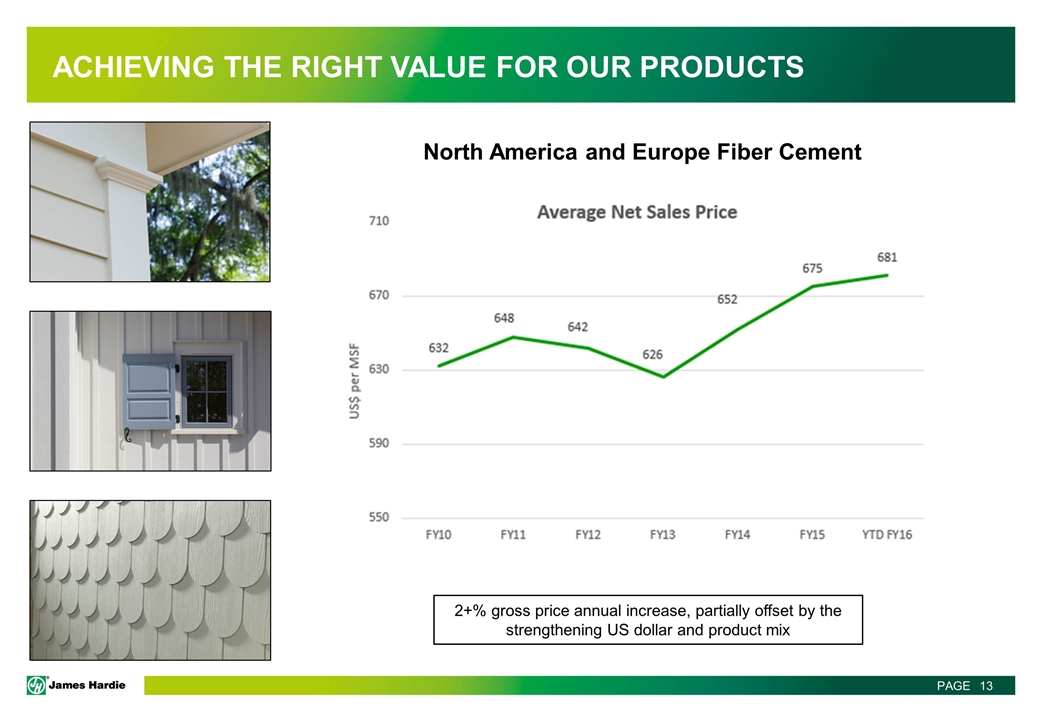
North America and Europe Fiber Cement ACHIEVING THE RIGHT VALUE FOR OUR PRODUCTS 2+% gross price annual increase, partially offset by the strengthening US dollar and product mix
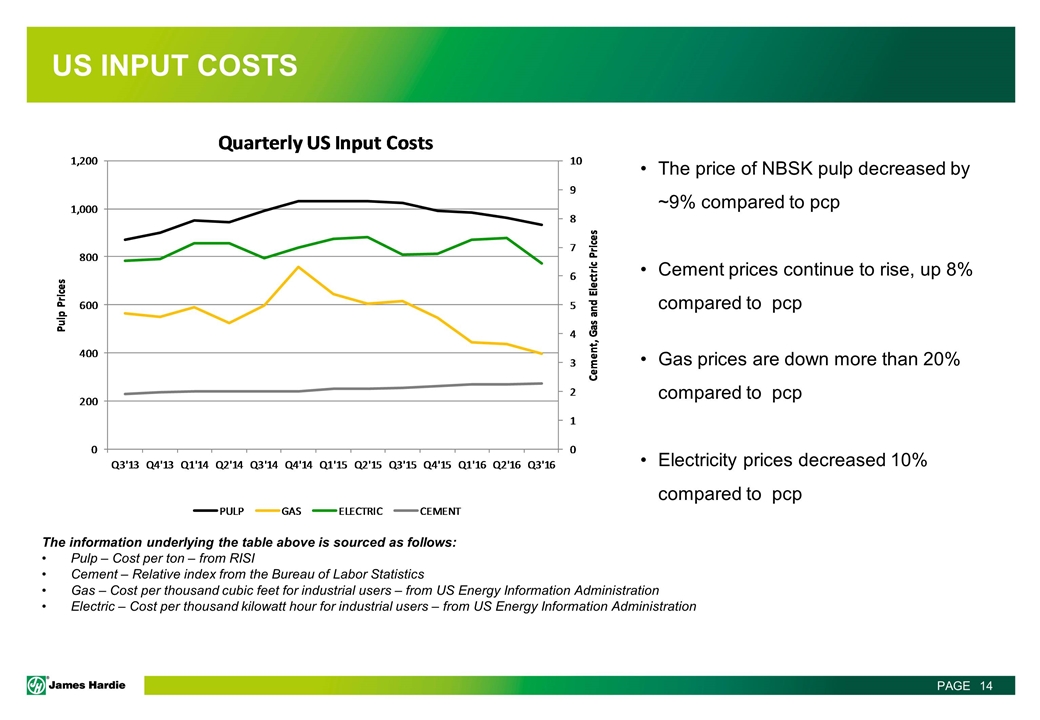
US INPUT COSTS The price of NBSK pulp decreased by ~9% compared to pcp Cement prices continue to rise, up 8% compared to pcp Gas prices are down more than 20% compared to pcp Electricity prices decreased 10% compared to pcp The information underlying the table above is sourced as follows: Pulp – Cost per ton – from RISI Cement – Relative index from the Bureau of Labor Statistics Gas – Cost per thousand cubic feet for industrial users – from US Energy Information Administration Electric – Cost per thousand kilowatt hour for industrial users – from US Energy Information Administration

NORTH AMERICA AND EUROPE: DELIVERING STRONG RETURNS YTD EBIT Margin up 340 bps to 25.1% 1 Excludes asset impairment charges of US$14.3 million in 4th quarter FY12, US$5.8 million in 3rd quarter FY13 and US$11.1 million in 4th quarter FY13
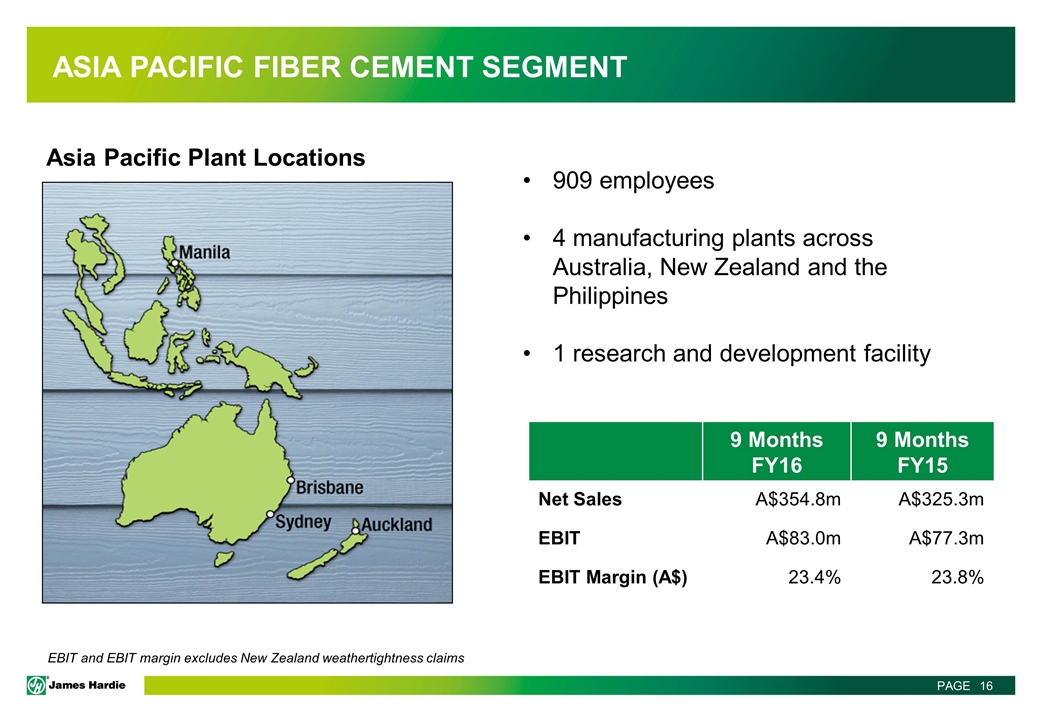
909 employees 4 manufacturing plants across Australia, New Zealand and the Philippines 1 research and development facility EBIT and EBIT margin excludes New Zealand weathertightness claims ASIA PACIFIC FIBER CEMENT SEGMENT 9 Months FY16 9 Months FY15 Net Sales A$354.8m A$325.3m EBIT A$83.0m A$77.3m EBIT Margin (A$) 23.4% 23.8% Asia Pacific Plant Locations
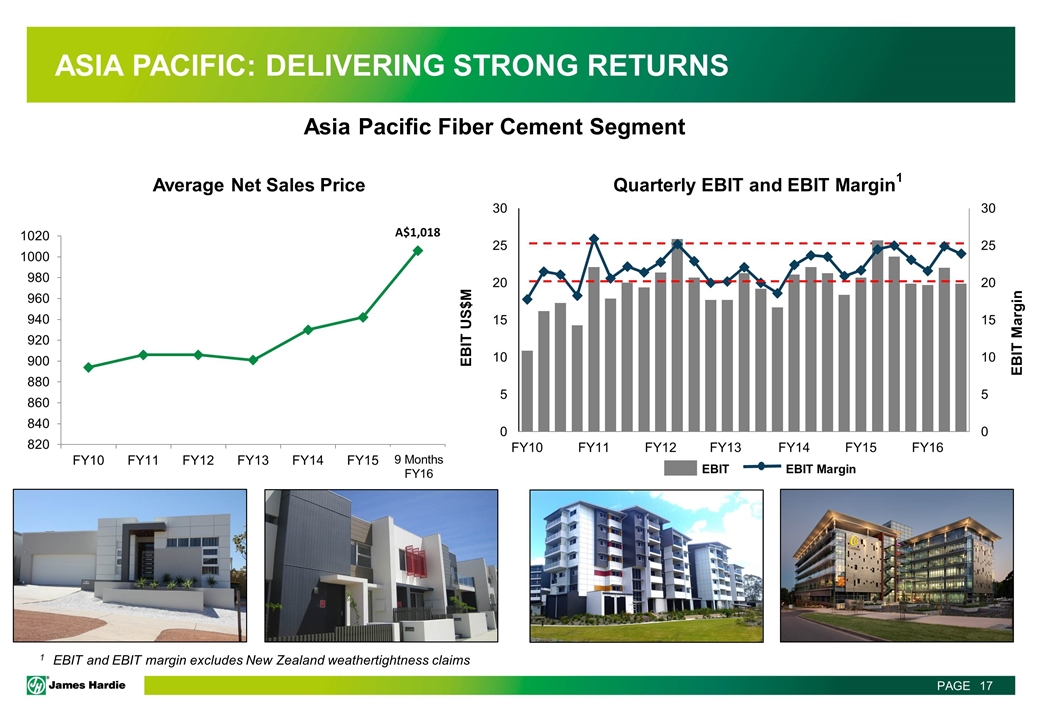
1 EBIT and EBIT margin excludes New Zealand weathertightness claims Quarterly EBIT and EBIT Margin1 EBIT EBIT Margin ASIA PACIFIC: DELIVERING STRONG RETURNS Asia Pacific Fiber Cement Segment Average Net Sales Price 9 Months FY16
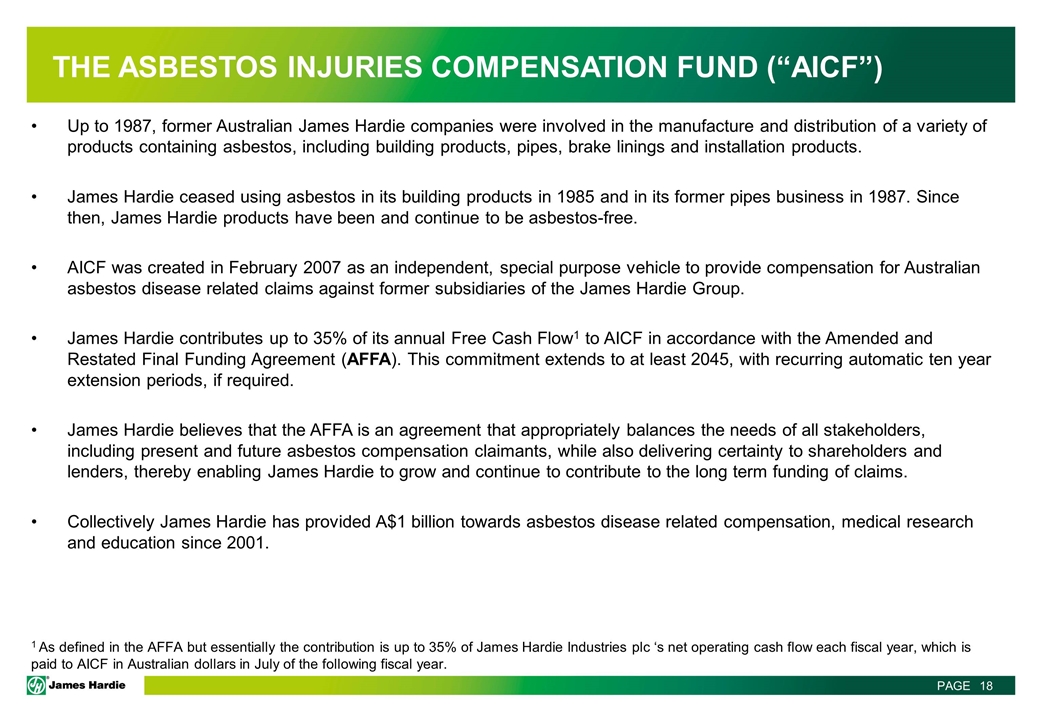
THE ASBESTOS INJURIES COMPENSATION FUND (“AICF”) Up to 1987, former Australian James Hardie companies were involved in the manufacture and distribution of a variety of products containing asbestos, including building products, pipes, brake linings and installation products. James Hardie ceased using asbestos in its building products in 1985 and in its former pipes business in 1987. Since then, James Hardie products have been and continue to be asbestos-free. AICF was created in February 2007 as an independent, special purpose vehicle to provide compensation for Australian asbestos disease related claims against former subsidiaries of the James Hardie Group. James Hardie contributes up to 35% of its annual Free Cash Flow1 to AICF in accordance with the Amended and Restated Final Funding Agreement (AFFA). This commitment extends to at least 2045, with recurring automatic ten year extension periods, if required. James Hardie believes that the AFFA is an agreement that appropriately balances the needs of all stakeholders, including present and future asbestos compensation claimants, while also delivering certainty to shareholders and lenders, thereby enabling James Hardie to grow and continue to contribute to the long term funding of claims. Collectively James Hardie has provided A$1 billion towards asbestos disease related compensation, medical research and education since 2001. 1 As defined in the AFFA but essentially the contribution is up to 35% of James Hardie Industries plc ‘s net operating cash flow each fiscal year, which is paid to AICF in Australian dollars in July of the following fiscal year.
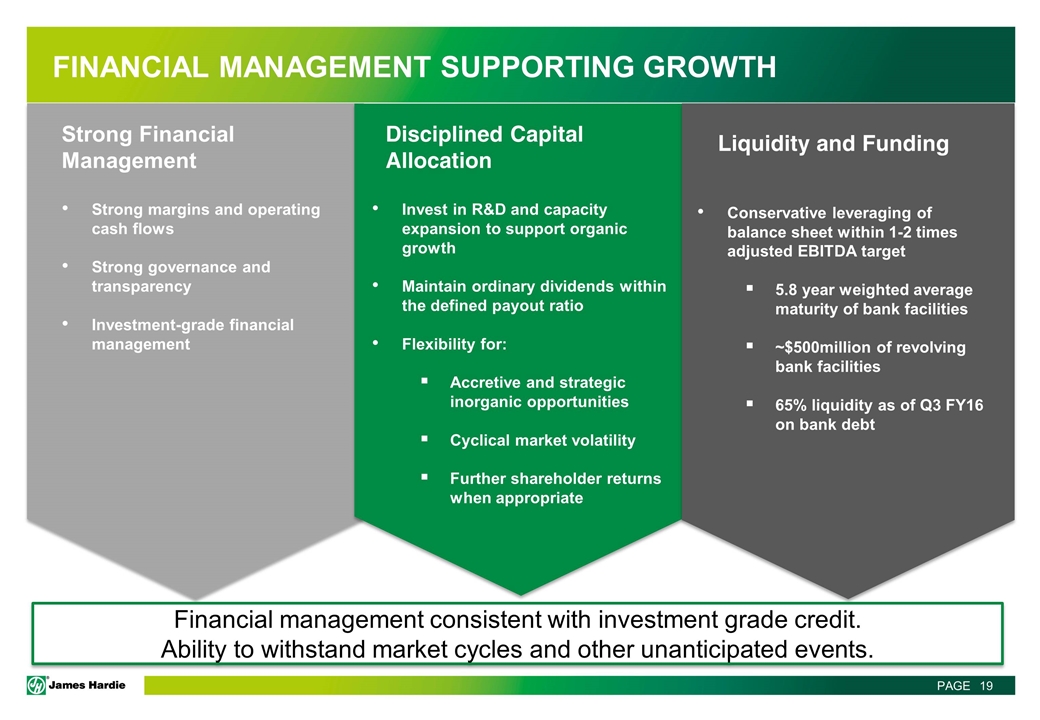
FINANCIAL MANAGEMENT SUPPORTING GROWTH Strong Financial Management Disciplined Capital Allocation Liquidity and Funding Strong margins and operating cash flows Strong governance and transparency Investment-grade financial management Invest in R&D and capacity expansion to support organic growth Maintain ordinary dividends within the defined payout ratio Flexibility for: Accretive and strategic inorganic opportunities Cyclical market volatility Further shareholder returns when appropriate Conservative leveraging of balance sheet within 1-2 times adjusted EBITDA target 5.8 year weighted average maturity of bank facilities ~$500million of revolving bank facilities 65% liquidity as of Q3 FY16 on bank debt Financial management consistent with investment grade credit. Ability to withstand market cycles and other unanticipated events.

SUMMARY Clear market leader with manufacturing and competitive advantages supported by an annual R&D spend of around US$30m, combined with in-house product development and technical expertise Targeting North America & Europe Fiber Cement Segment EBIT margins of between 20%-25% for FY16 and beyond Operating in an industry with high barriers to entry – now producing 7th generation fiber cement Core strategy is 35/90: growing fiber cement’s category share of North America exterior siding from 18% to 35% whilst maintaining c.90% market share US Housing market continues to improve and input costs (with the exception of cement) continue to trend downwards
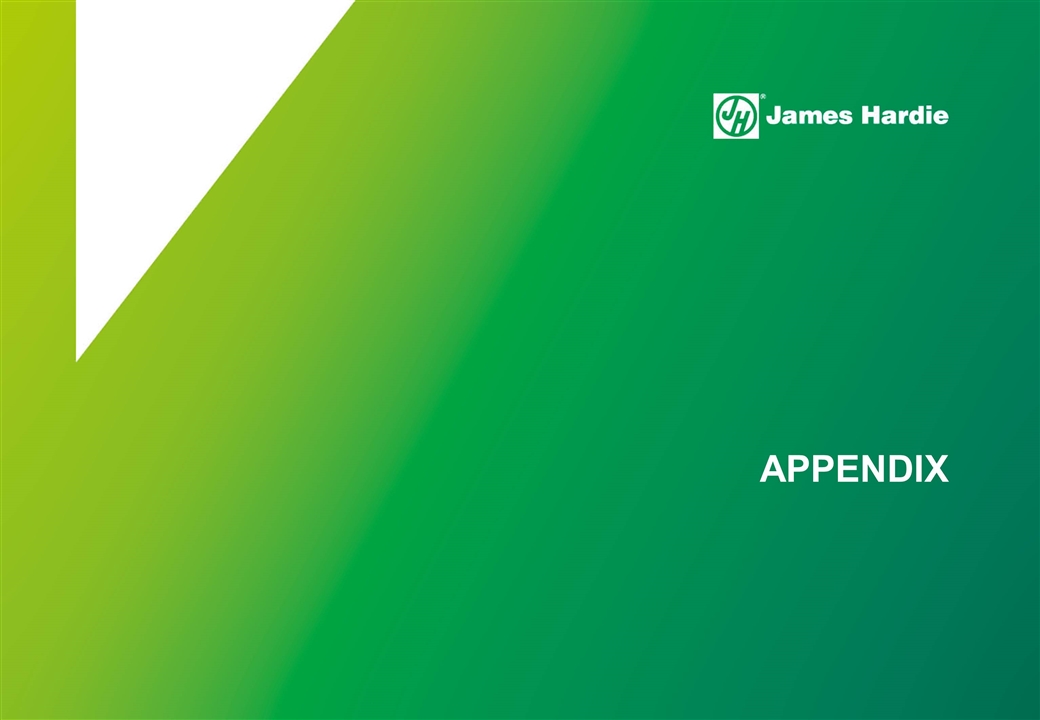
APPENDIX

U.S. MARKETPLACE
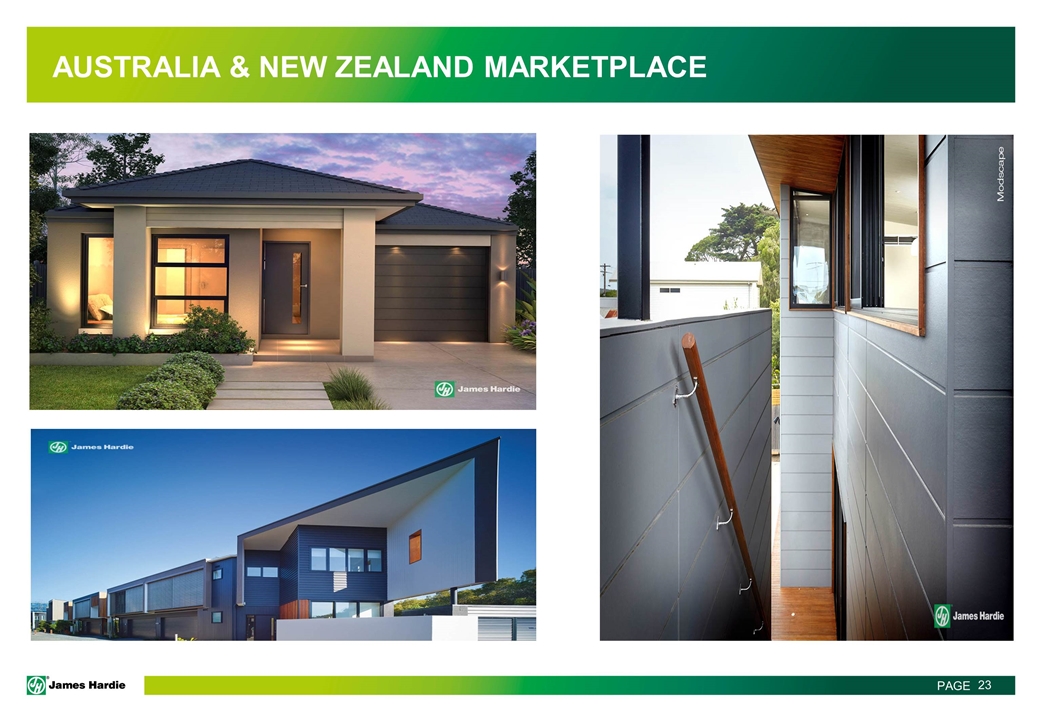
AUSTRALIA & NEW ZEALAND MARKETPLACE
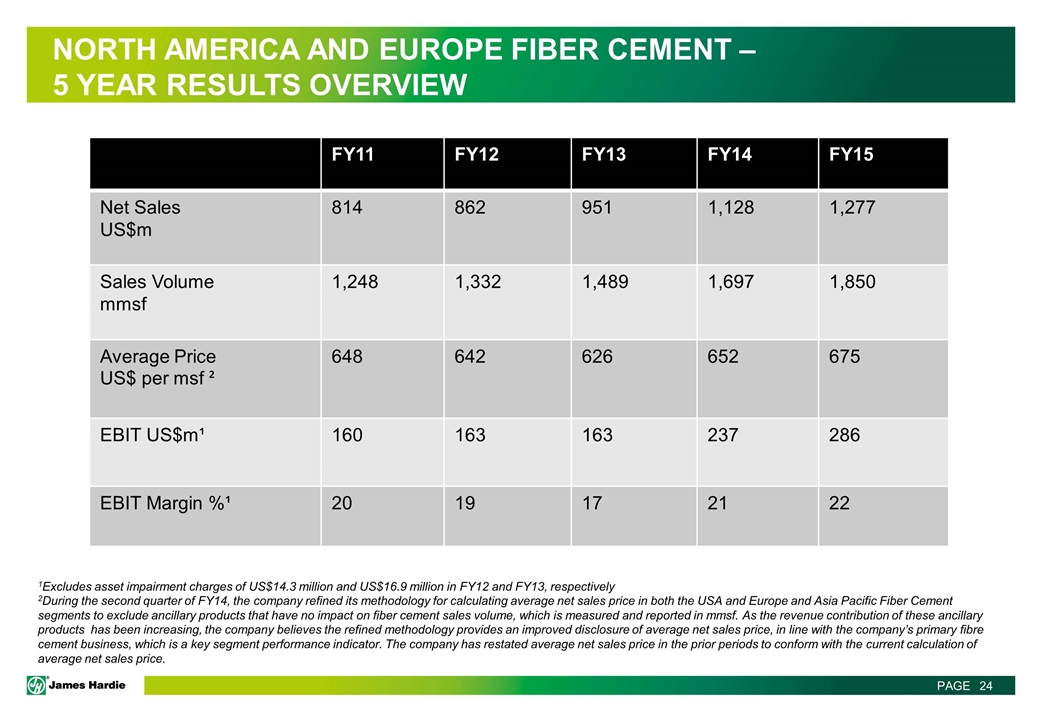
FY11 FY12 FY13 FY14 FY15 Net Sales US$m 814 862 951 1,128 1,277 Sales Volume mmsf 1,248 1,332 1,489 1,697 1,850 Average Price US$ per msf ² 648 642 626 652 675 EBIT US$m¹ 160 163 163 237 286 EBIT Margin %¹ 20 19 17 21 22 1Excludes asset impairment charges of US$14.3 million and US$16.9 million in FY12 and FY13, respectively 2During the second quarter of FY14, the company refined its methodology for calculating average net sales price in both the USA and Europe and Asia Pacific Fiber Cement segments to exclude ancillary products that have no impact on fiber cement sales volume, which is measured and reported in mmsf. As the revenue contribution of these ancillary products has been increasing, the company believes the refined methodology provides an improved disclosure of average net sales price, in line with the company’s primary fibre cement business, which is a key segment performance indicator. The company has restated average net sales price in the prior periods to conform with the current calculation of average net sales price. NORTH AMERICA AND EUROPE FIBER CEMENT – 5 YEAR RESULTS OVERVIEW
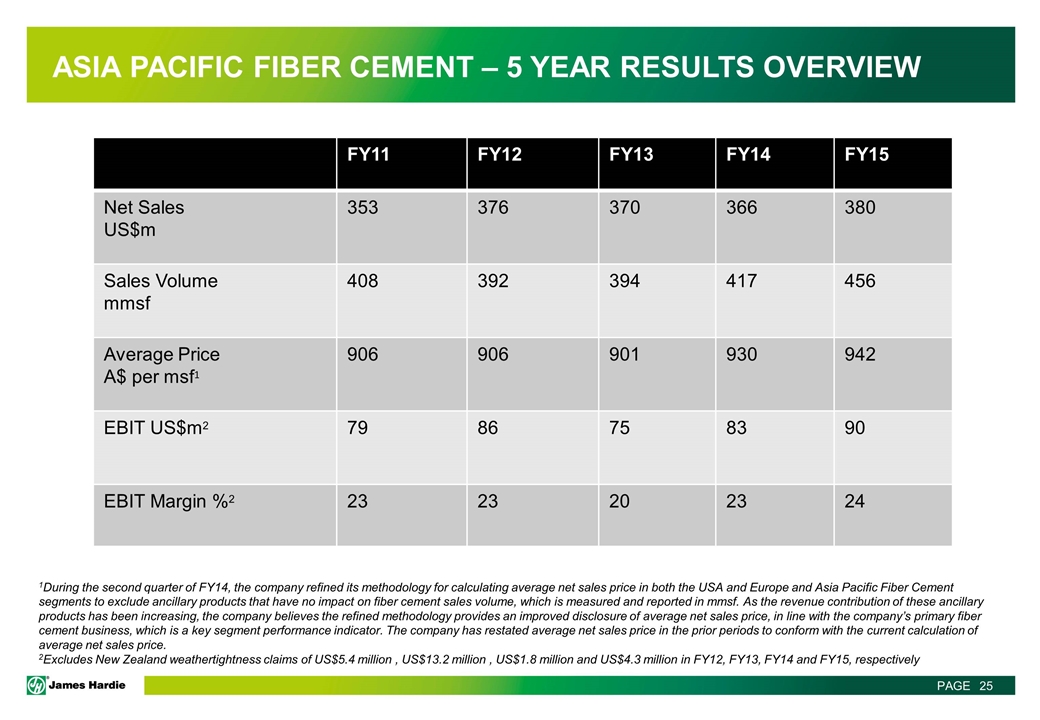
1During the second quarter of FY14, the company refined its methodology for calculating average net sales price in both the USA and Europe and Asia Pacific Fiber Cement segments to exclude ancillary products that have no impact on fiber cement sales volume, which is measured and reported in mmsf. As the revenue contribution of these ancillary products has been increasing, the company believes the refined methodology provides an improved disclosure of average net sales price, in line with the company’s primary fiber cement business, which is a key segment performance indicator. The company has restated average net sales price in the prior periods to conform with the current calculation of average net sales price. 2Excludes New Zealand weathertightness claims of US$5.4 million , US$13.2 million , US$1.8 million and US$4.3 million in FY12, FY13, FY14 and FY15, respectively FY11 FY12 FY13 FY14 FY15 Net Sales US$m 353 376 370 366 380 Sales Volume mmsf 408 392 394 417 456 Average Price A$ per msf1 906 906 901 930 942 EBIT US$m2 79 86 75 83 90 EBIT Margin %2 23 23 20 23 24 ASIA PACIFIC FIBER CEMENT – 5 YEAR RESULTS OVERVIEW
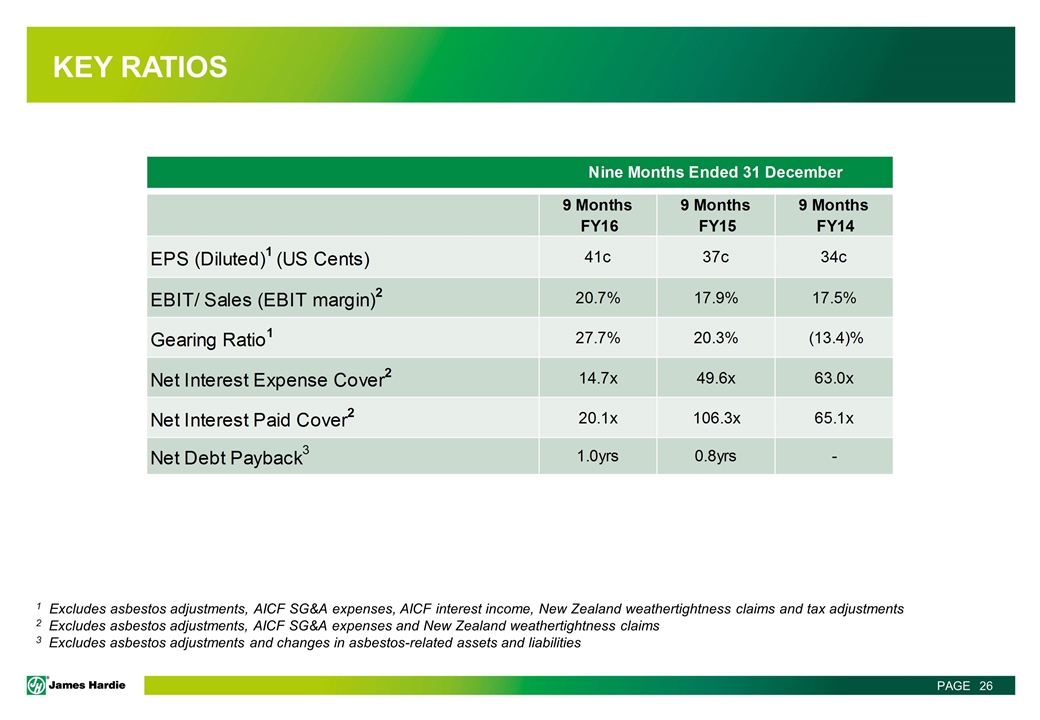
1 Excludes asbestos adjustments, AICF SG&A expenses, AICF interest income, New Zealand weathertightness claims and tax adjustments 2 Excludes asbestos adjustments, AICF SG&A expenses and New Zealand weathertightness claims 3 Excludes asbestos adjustments and changes in asbestos-related assets and liabilities KEY RATIOS
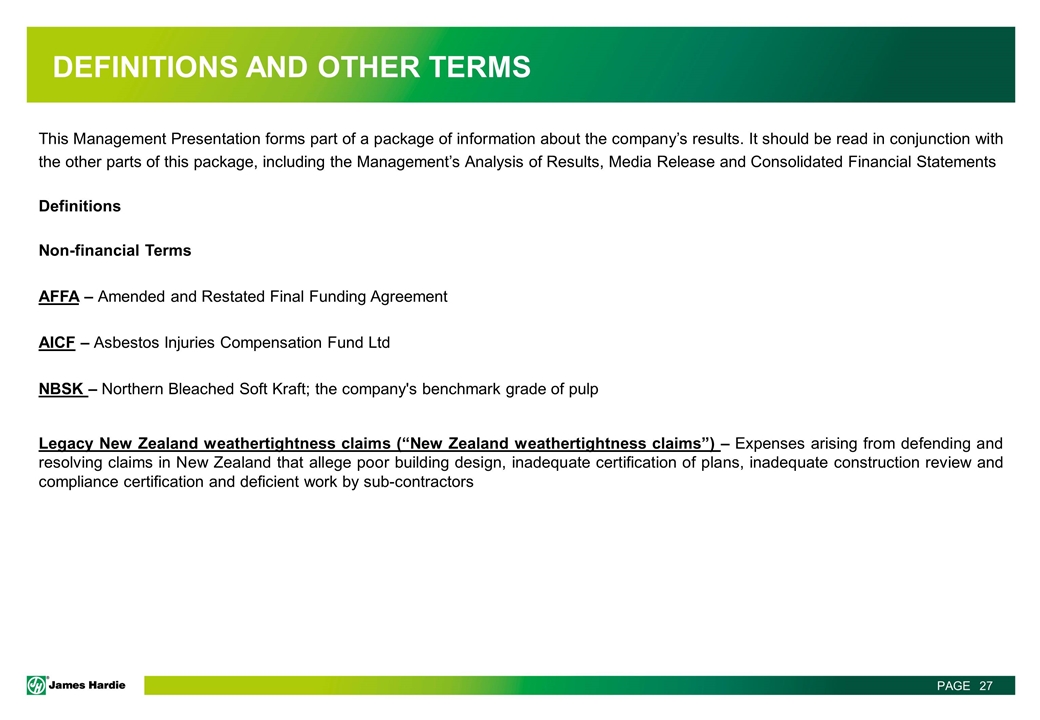
DEFINITIONS AND OTHER TERMS This Management Presentation forms part of a package of information about the company’s results. It should be read in conjunction with the other parts of this package, including the Management’s Analysis of Results, Media Release and Consolidated Financial Statements Definitions Non-financial Terms AFFA – Amended and Restated Final Funding Agreement AICF – Asbestos Injuries Compensation Fund Ltd NBSK – Northern Bleached Soft Kraft; the company's benchmark grade of pulp Legacy New Zealand weathertightness claims (“New Zealand weathertightness claims”) – Expenses arising from defending and resolving claims in New Zealand that allege poor building design, inadequate certification of plans, inadequate construction review and compliance certification and deficient work by sub-contractors
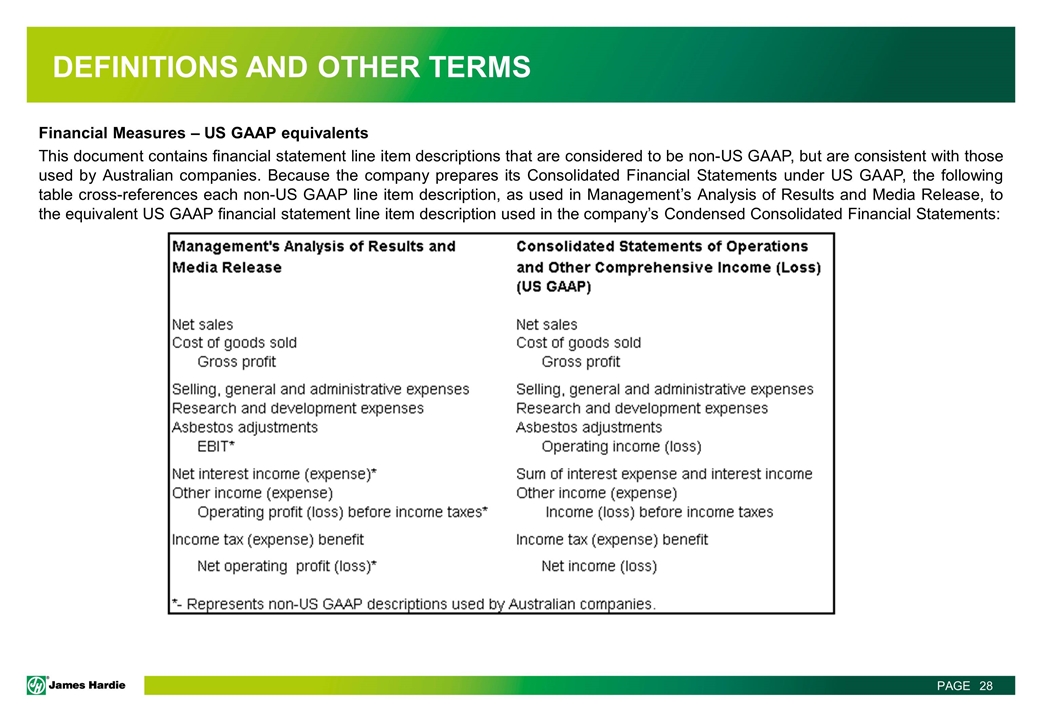
DEFINITIONS AND OTHER TERMS Financial Measures – US GAAP equivalents This document contains financial statement line item descriptions that are considered to be non-US GAAP, but are consistent with those used by Australian companies. Because the company prepares its Consolidated Financial Statements under US GAAP, the following table cross-references each non-US GAAP line item description, as used in Management’s Analysis of Results and Media Release, to the equivalent US GAAP financial statement line item description used in the company’s Condensed Consolidated Financial Statements:
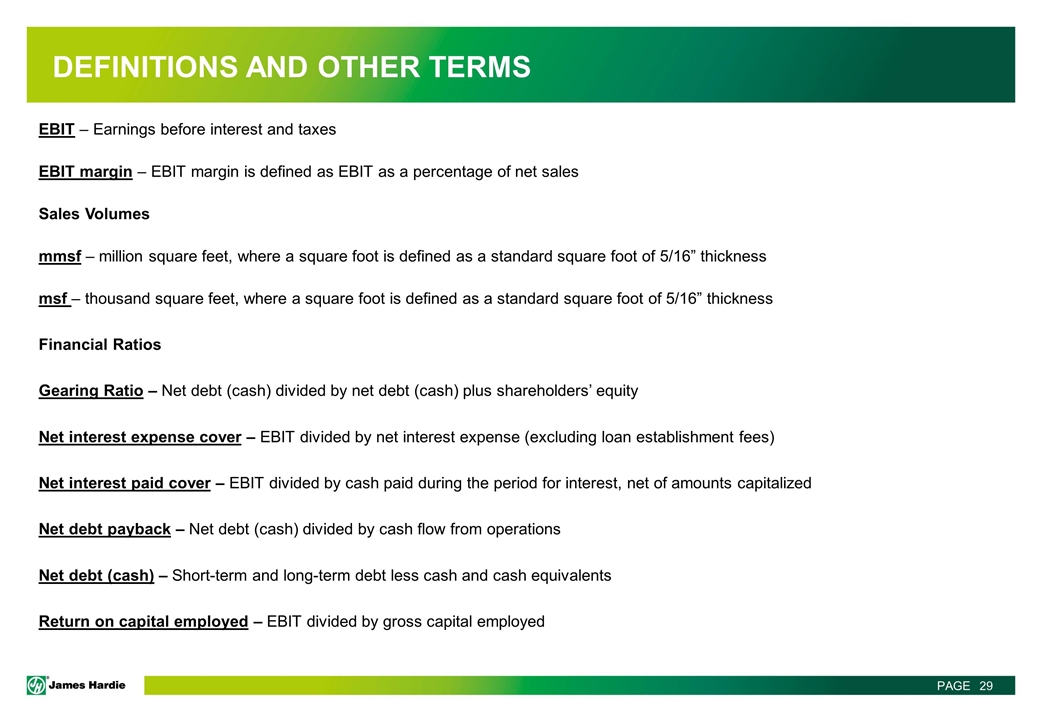
DEFINITIONS AND OTHER TERMS EBIT – Earnings before interest and taxes EBIT margin – EBIT margin is defined as EBIT as a percentage of net sales Sales Volumes mmsf – million square feet, where a square foot is defined as a standard square foot of 5/16” thickness msf – thousand square feet, where a square foot is defined as a standard square foot of 5/16” thickness Financial Ratios Gearing Ratio – Net debt (cash) divided by net debt (cash) plus shareholders’ equity Net interest expense cover – EBIT divided by net interest expense (excluding loan establishment fees) Net interest paid cover – EBIT divided by cash paid during the period for interest, net of amounts capitalized Net debt payback – Net debt (cash) divided by cash flow from operations Net debt (cash) – Short-term and long-term debt less cash and cash equivalents Return on capital employed – EBIT divided by gross capital employed
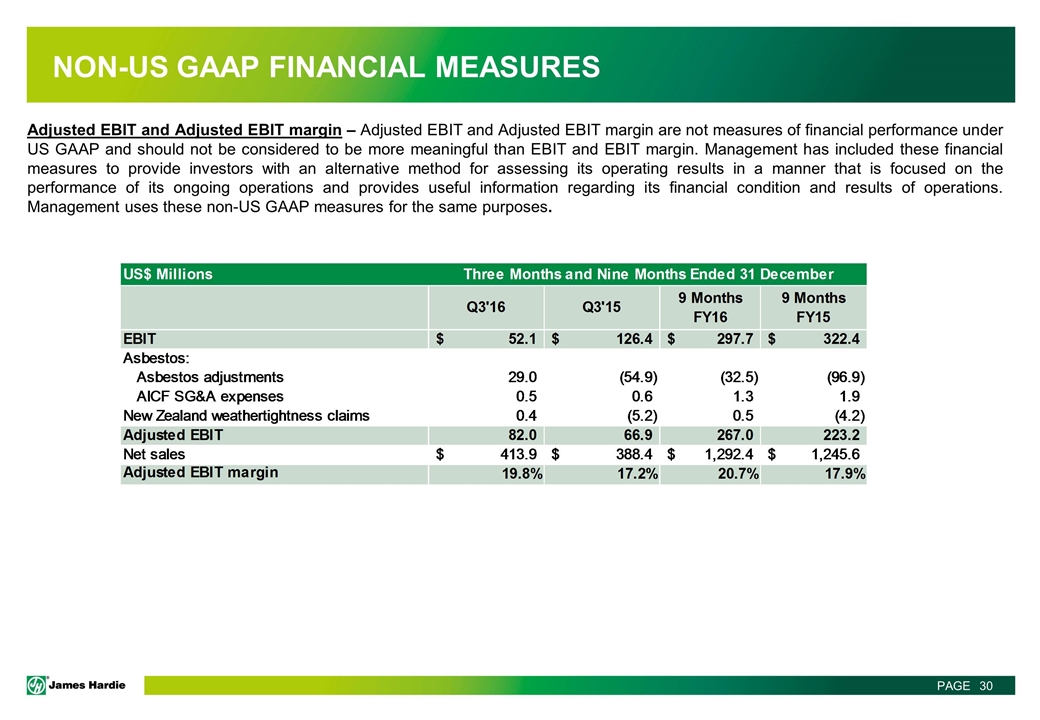
Adjusted EBIT and Adjusted EBIT margin – Adjusted EBIT and Adjusted EBIT margin are not measures of financial performance under US GAAP and should not be considered to be more meaningful than EBIT and EBIT margin. Management has included these financial measures to provide investors with an alternative method for assessing its operating results in a manner that is focused on the performance of its ongoing operations and provides useful information regarding its financial condition and results of operations. Management uses these non-US GAAP measures for the same purposes. NON-US GAAP FINANCIAL MEASURES
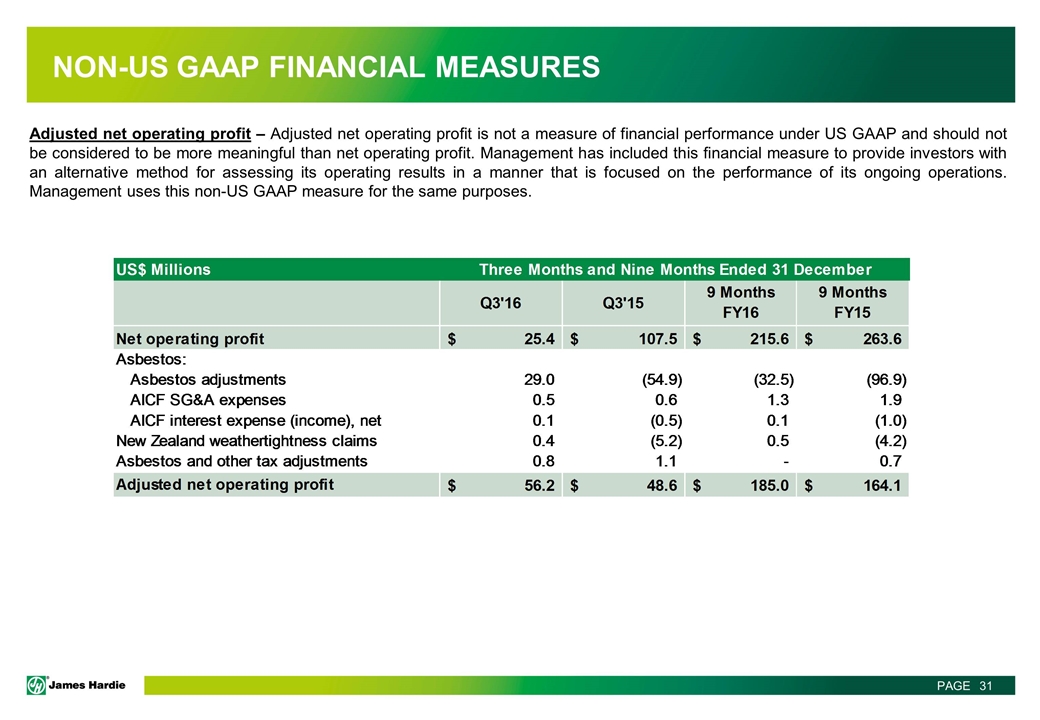
Adjusted net operating profit – Adjusted net operating profit is not a measure of financial performance under US GAAP and should not be considered to be more meaningful than net operating profit. Management has included this financial measure to provide investors with an alternative method for assessing its operating results in a manner that is focused on the performance of its ongoing operations. Management uses this non-US GAAP measure for the same purposes. NON-US GAAP FINANCIAL MEASURES
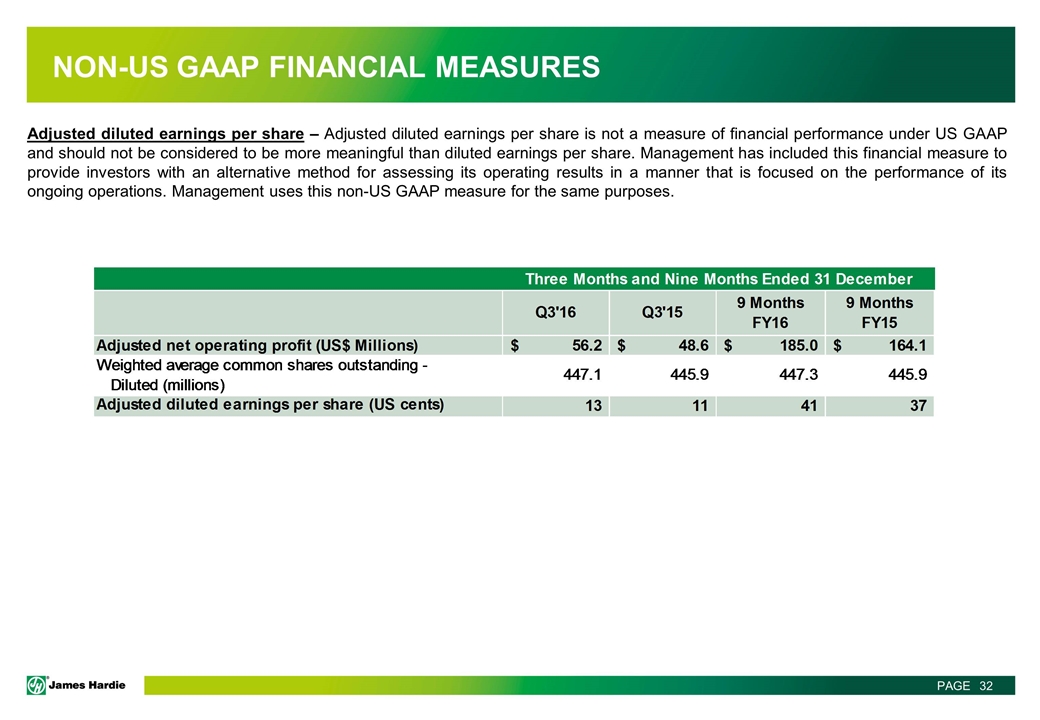
Adjusted diluted earnings per share – Adjusted diluted earnings per share is not a measure of financial performance under US GAAP and should not be considered to be more meaningful than diluted earnings per share. Management has included this financial measure to provide investors with an alternative method for assessing its operating results in a manner that is focused on the performance of its ongoing operations. Management uses this non-US GAAP measure for the same purposes. NON-US GAAP FINANCIAL MEASURES
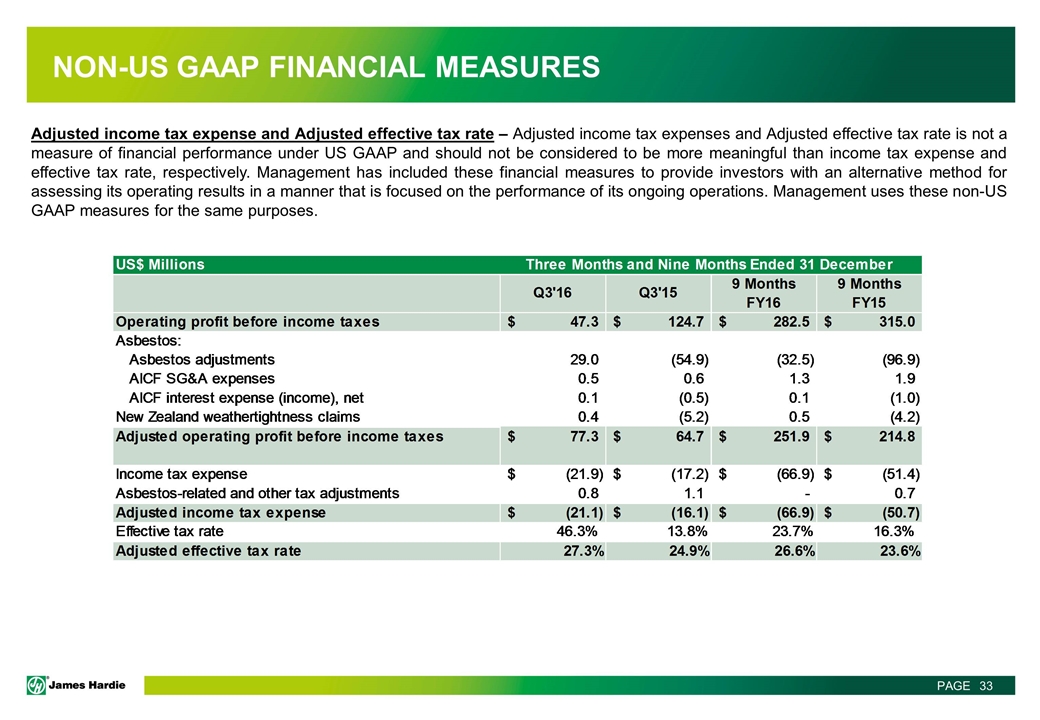
Adjusted income tax expense and Adjusted effective tax rate – Adjusted income tax expenses and Adjusted effective tax rate is not a measure of financial performance under US GAAP and should not be considered to be more meaningful than income tax expense and effective tax rate, respectively. Management has included these financial measures to provide investors with an alternative method for assessing its operating results in a manner that is focused on the performance of its ongoing operations. Management uses these non-US GAAP measures for the same purposes. NON-US GAAP FINANCIAL MEASURES

NON-US GAAP FINANCIAL MEASURES Adjusted EBITDA – is not a measure of financial performance under US GAAP and should not be considered an alternative to, or more meaningful than, income from operations, net income or cash flows as defined by US GAAP or as a measure of profitability or liquidity. Not all companies calculate Adjusted EBITDA in the same manner as James Hardie has and, accordingly, Adjusted EBITDA may not be comparable with other companies. Management has included information concerning Adjusted EBITDA because it believes that this data is commonly used by investors to evaluate the ability of a company’s earnings from its core business operations to satisfy its debt, capital expenditure and working capital requirements.
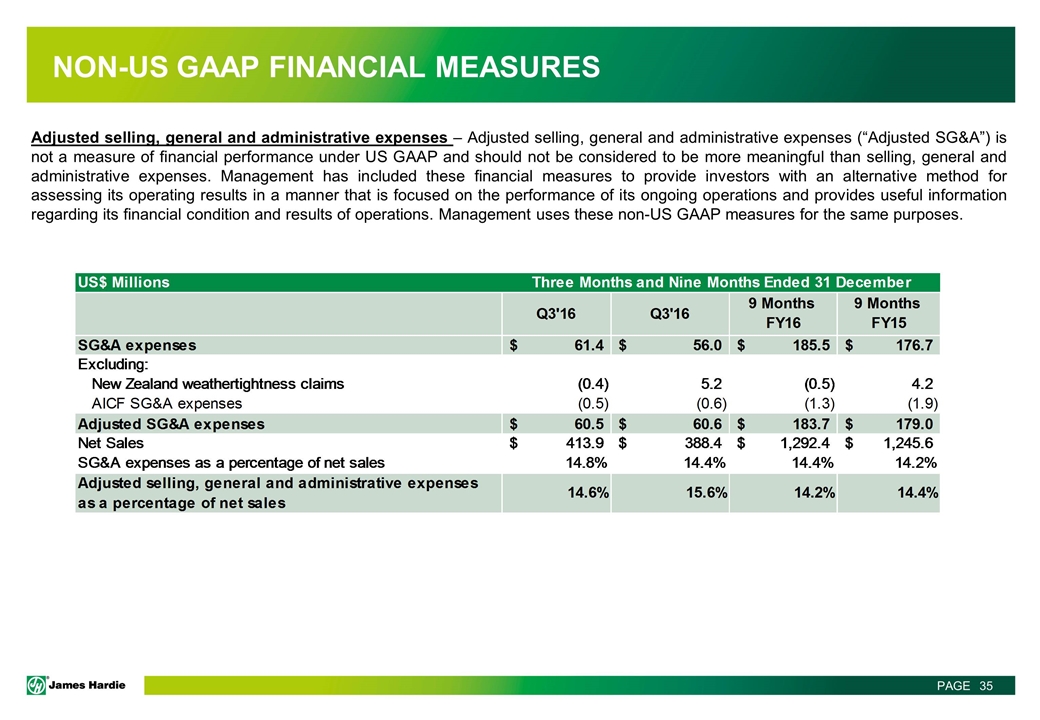
Adjusted selling, general and administrative expenses – Adjusted selling, general and administrative expenses (“Adjusted SG&A”) is not a measure of financial performance under US GAAP and should not be considered to be more meaningful than selling, general and administrative expenses. Management has included these financial measures to provide investors with an alternative method for assessing its operating results in a manner that is focused on the performance of its ongoing operations and provides useful information regarding its financial condition and results of operations. Management uses these non-US GAAP measures for the same purposes. NON-US GAAP FINANCIAL MEASURES
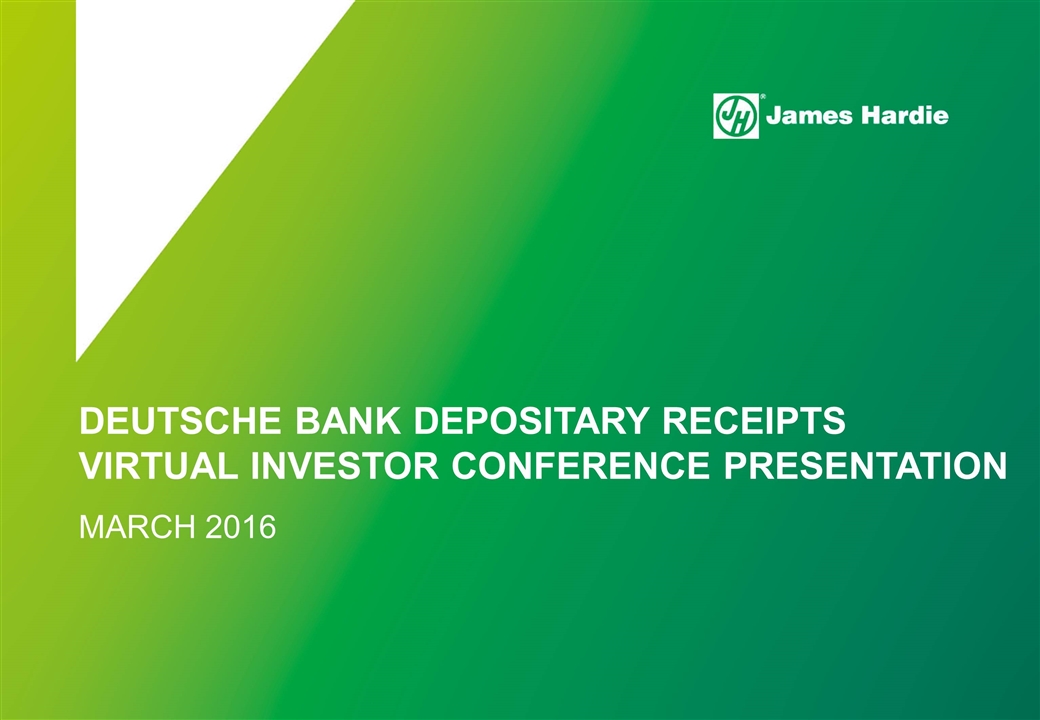
DEUTSCHE BANK DEPOSITARY RECEIPTS VIRTUAL INVESTOR CONFERENCE PRESENTATION MARCH 2016